A flicker of puzzlement flashed between the armed guards on the border of Moldova and Ukraine. They made calls; I waited.
Thirty minutes later – entry ticket issued, passport stamped – I was on my way to an extraordinary wine and slow food resort, Frumushika-Nova, in Ukraine’s Odesa region. It’s 50km from the border with Moldova – close enough to be added to Moldova’s wine route when the war with Russia is over.
The owner of Frumushika-Nova, sheep farmer and entrepreneur Alexander Palariev, meets me on a dirt track that dissects the massive Tarutino Steppe – 5,200ha of protected land in a 24,521ha wilderness.
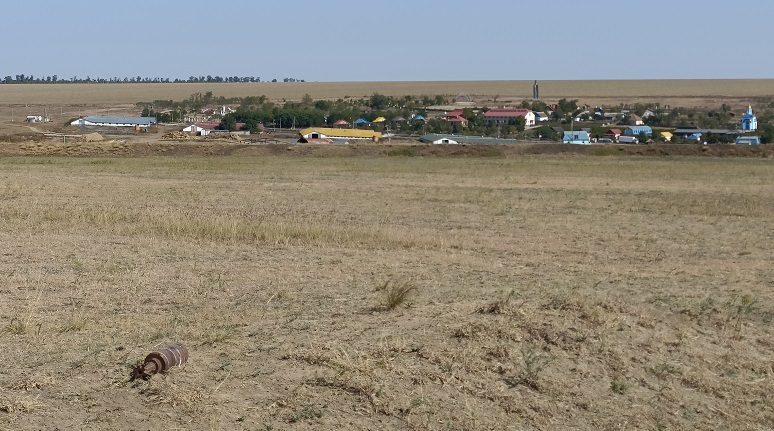
Suddenly, he swerves off the track. He shows me scattered munitions and craters caused by artillery shells. These are from the last century when this swathe of rolling grassland was a Soviet army training base and Soviet tanks manoeuvred freely across the plains. Now, at the entrance to Alexander’s empire, there are blocks of concrete and ‘Czech Hedgehogs’ to slow down their advancement.
We slip between the obstacles and the tremendous scale of Frumushika-Nova’s ‘land of honey and wine and cheese’ (as the blue and yellow sign calls it) unfolds. There are kulan (wild donkeys) and saiga antelope galloping freely. There are 10ha of vines farmed without insecticides, fungicides, or herbicides. Varieties such as Cabernet Sauvignon, Merlot, Saperavi, Riesling, Muscat Ottonel, Chardonnay, Rkatsiteli, and Aligote as well as local grapes Sukholimanske, Citron of Magarach (Citronny Magaracha) and Ukraine’s flagship Odesa Black are growing here at a density of about 5,290 vines per hectare.
There are 5,000 karakul sheep, too, with their winter food stored in four massive barns. There are plans to breed 12,000 sheep here in three years’ time. In the place where his family once lived, the man who made his money from petrol stations in Odesa is building Europe’s largest sheep farm and helping to rewild the steppe.
“My idea is to rebuild this territory and make a national park,” he says, as we make our way from the steppe towards the buildings.
The nature park will bring more tourists to Frumushika-Nova, which roughly translates as “the new beauty”. Before the war with Russia, this new attraction had 15,000 visitors in three months. Alexander realised tourists need places to stay, so he is rebuilding the village where his father, Andriy Palariev, was born in 1933, and where an ancestor, Nikolai Palariev, bought land at the end of the 19th century with compensation from losing an arm in the Crimean War.
The rebuilt houses form an open-air ethnographic museum, the ‘Bessarabian village of Frumushyka-Nova’, which shows how Ukrainian, Moldavian, Bulgarian, German, and Jewish people lived in the 19th and 20th centuries – until the Soviet army evicted all the residents in 1946 and destroyed 460 homes in five villages.
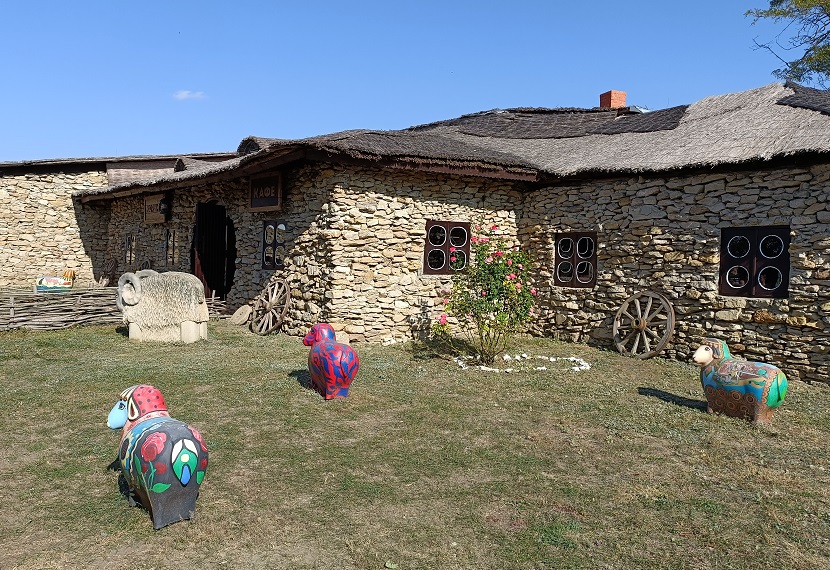
The tourists also need a place to eat, so Alexander has built a restaurant (above) and expanded it three times already. They also need something to quench their thirst. So, in 2019, the family planted 8ha of vines to supplement the 2ha that belonged to his ancestors and built a winery above the family’s old cellar.
Lamb is the signature dish in the restaurant. “Slow food, slow road,” Alexander quips, gesturing for me to take in all the sights as we bump along.
The next assault on my brain, which is trying to reconcile the scale of this project and the huge investment with the fact that Odesa is under constant attack from Russian missiles, is the monument park. It’s filled with statues of Russian leaders. 130 of them – including Lenin, Stalin, Trotsky, Gorky, and Dzerzhinsky – in ‘The Museum of Socialist Realism’, as it is called.
I ask if it’s controversial. Alexander replies: “It’s museum of Soviet time, not political – Soviet time.” Inspired by a park he visited in Lithuania – a museum of Soviet occupation – Alexander bought the monuments as Ukraine moved away from Russia politically.
“This is history,” he says, as statue after statue flash past the car window. “This is history bad, history hard. My family, my father, 12 persons deported to Siberia, 11 died the first winter. Only one come back to this land.”
After a moment of reflection, he continues: “I will write what bad they did.
“I want to make this part like a museum for humanity because they deported a lot of persons. This place not political, it’s so we look at past and don’t repeat the same mistakes. If we look at past, we can do better. Our family can be proud.”
Near the statues are two old planes, an old car, and an even older tractor…
Opposite is a botanical garden and a massive granite statue of a shepherd – a record-breaking 16.43m tall (17.93 if you include the base).
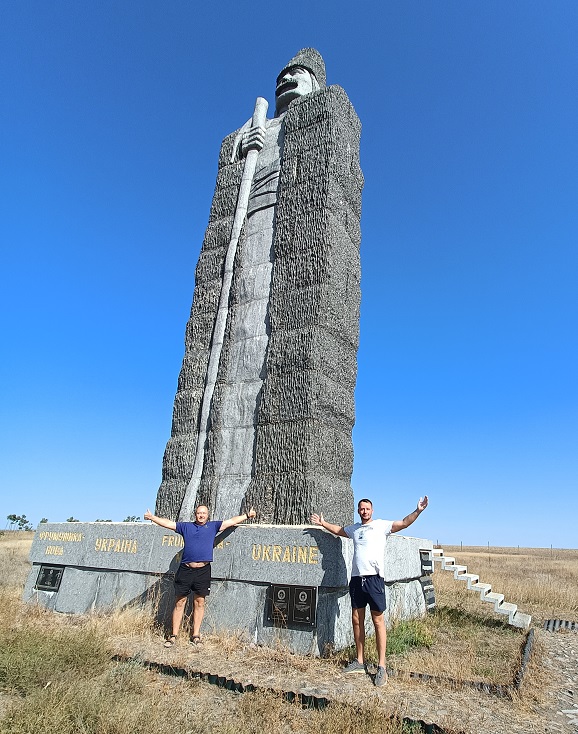
Alexander (pictured above with son Vladimir) admits it’s been an expensive project but doesn’t go into details. He started the sheep farm to help revive the village where his family came from. The initial idea was to make woollen coats for the Russian market, but that changed when Russia invaded Crimea in 2014. Instead, Alexander opened a chain of restaurants selling lamb-based dishes. There are now five restaurants in Odesa, three in Bulgaria, and the one I’m heading to at Frumushika-Nova.
Signs on the way read: ‘Happiness is near” and ‘Next bar 500km’.
In the restaurant, I taste some wines with the winemaker, Alexander’s son Vladimir. These are not what I was expecting either. A pet-nat featuring Kadarka from the original 2ha vineyard, an unfiltered rosé made from Cabernet Sauvignon, and a skin-contact Chardonnay. These are from the winery’s ‘new trends’ range of experimental wines. There is also a more standard range featuring traditional-method varietals made from Sukholimanske (a cross between Chardonnay and Plavai), Chardonnay and Pinot Noir, dry reds from Odesa Black and Cabernet Sauvignon, and an oaked Chardonnay. Total annual production is around 15,000 bottles, although they have a permit to produce 100,000 bottles a year.
We stop the tasting after the three experimental wines as Vladimir has some urgent paperwork to complete – but he wants to show me around the winery first and let me taste some new wines from the tanks.
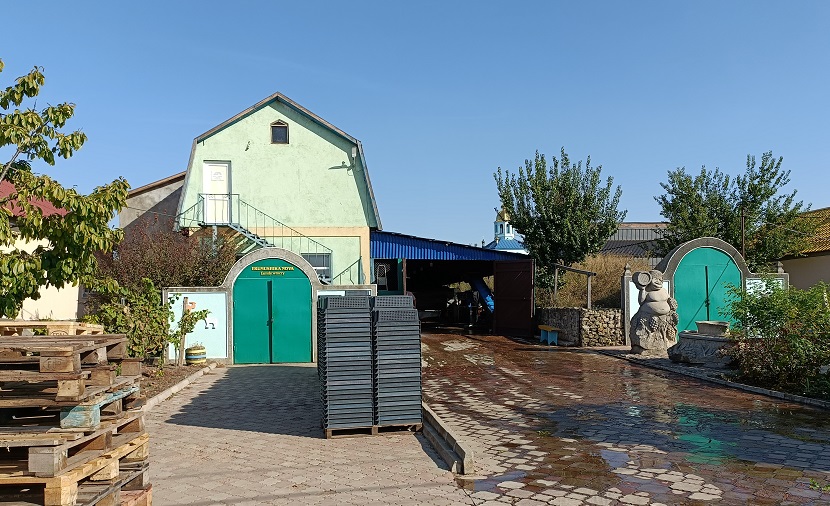
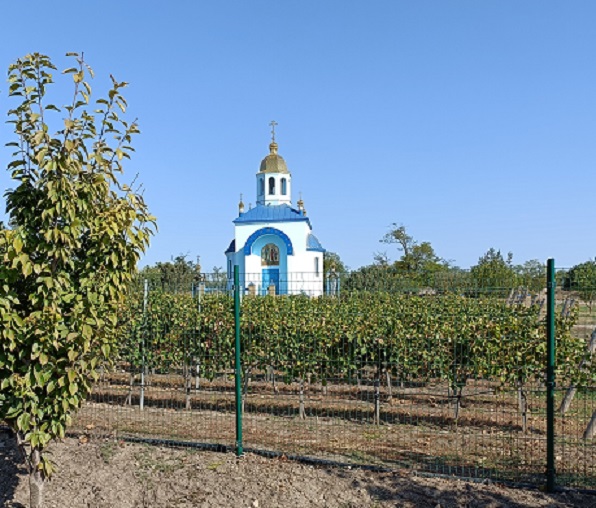
On the way to the winery (top), we pass a new church (above) and small (0.43ha) vineyard growing the piwi variety Sauvignon Nepis. In the winery I taste the two most recent vintages of this Sauvignon Blanc and Bianca crossing from the tank. Both were fermented using native yeasts, but the 2022 got stuck with 8g/L of residual sugar so the current plan is to blend it with the dry 2023 wine.
I also taste the signature red, Odesa Black, a crossing of Alicante Bouschet and Cabernet Sauvignon created in Odesa’s Tairov Institute. It’s very dark in colour with intense black fruit aromas and flavours, and hints of mint. Most of the whites are made in stainless-steel while the reds are aged in oak barrels in a beautiful cellar (below).
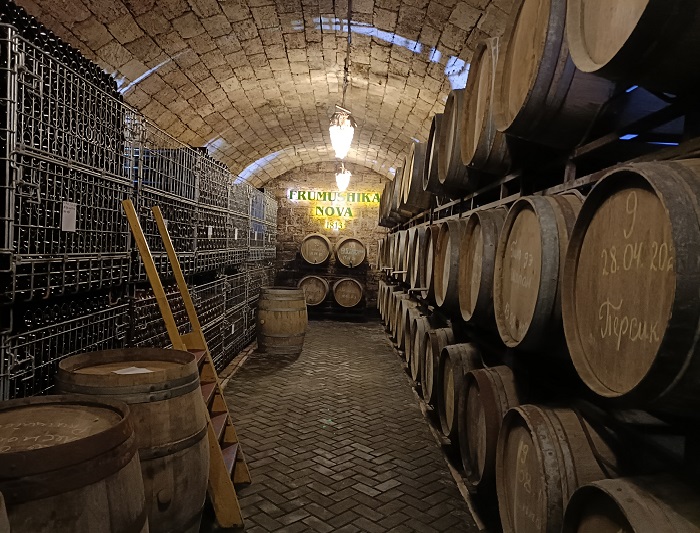
This barrel cellar was one of the first structures built at the start of the project in 2006 – along with the winter quarters for the sheep and the shepherd's house.
Vladimir’s grandfather, Andriy, supervised the construction of the 5m-wide, 25m-long cellar. It looks a bit like a bunker because the plans came from a sapper’s manual. Builders from the neighbouring village of Starosillya helped. Incentivised by an offer to buy their grapes at the best price if the cellar was constructed in time for the next harvest, they built it in 45 days.
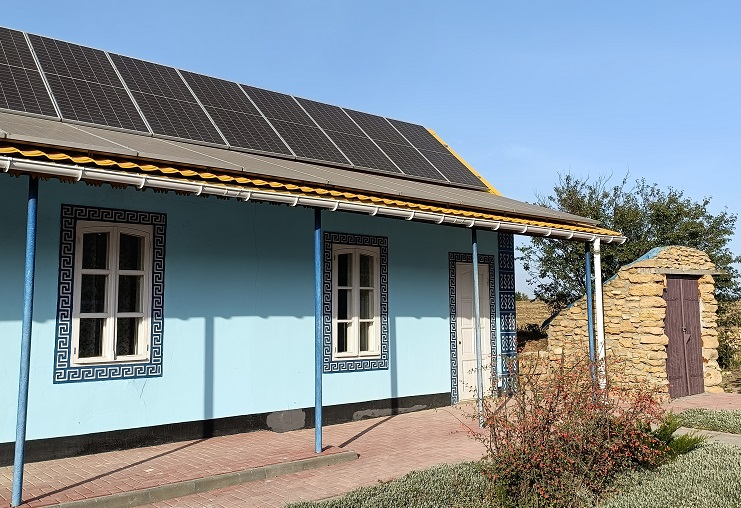
Back at the restaurant, Alexander gathers a package and a bottle of Sukholimanske fizz and tells me to pick up my glass. I follow him to the village he has been reconstructing since 2006.
The short street is the best road I’ve been on since crossing the border and entering Ukraine. It’s a beautiful, peaceful wine resort which teaches the history of the area. At every glance, I spot another surprise. On some roofs there are solar panels (above), which power the whole village. New Riesling vines have been planted next to one village house, showing how people used to be self-sufficient here a hundred years ago.
The village is nearly ready to welcome guests. Workers are adding the finishing touches. We interrupt a woman hanging embroidered pictures. Alexander unwraps the package he’s been carrying. It’s an antique clock. “It’s German,” he says. “The Russians confiscated it in 1945.”
I tell him I’m still struggling with the logic of investing so much money in a wine tourist destination during such a brutal war.
“It will be a national park. Tourists will come… there will be tasty wine, tasty food,” he responds. He doesn’t see why I’m questioning the business plan. I sip my glass of sparkling Sukholimanske and admire his optimism. In the short term, he believes the peace and quiet will appeal to Ukrainian tourists.
He wants to show me the pool, the artificial pond where you can swim and the “bee sanatorium” where you can get honey treatments, but it’s getting late, and I don’t want to push my luck. It seems very safe here but, most nights at home, the news since February 2022 has been of missiles, explosions, war and death. I try to bid farewell to my gracious host.
“One more surprise,” he insists, beckoning me towards another of the village houses. Near the entrance is an old vine. Alexander reckons it’s 150 years old. The trunk’s circumference is 17cm. “Riesling,” he says. A reminder that large numbers of German farmers colonised the unpopulated expanses of southern Ukraine in the 18th and 19th centuries. They were granted free land, freedom of religion, local autonomy, tax exemptions for 10 to 30 years, immunity from military service, and interest-free loans.
I get the concept now. Rewilding the Tarutino Steppe will take visitors back to how things were 500 years ago. The houses show how people from all cultures lived in harmony 100 to 200 years ago. The monuments represent the bad years of the Soviet occupation. Wine has long been a part of this complex landscape. I’m writing about more than wine here. This is about the past and the hope for a better future.
“Hello,” the armed border guard says, with a smile, before I even show my British passport. She clearly remembers me. I think I must have been the only wine writer crossing into Odesa today.
Back in my hotel room in Moldova, I switch on the TV news. A Russian missile has devastated the village of Hroza, hitting a cafe hosting a wake for a Ukrainian soldier. Fifty-nine lives lost in an instant in one of the worst episodes in Moscow’s bloody war.


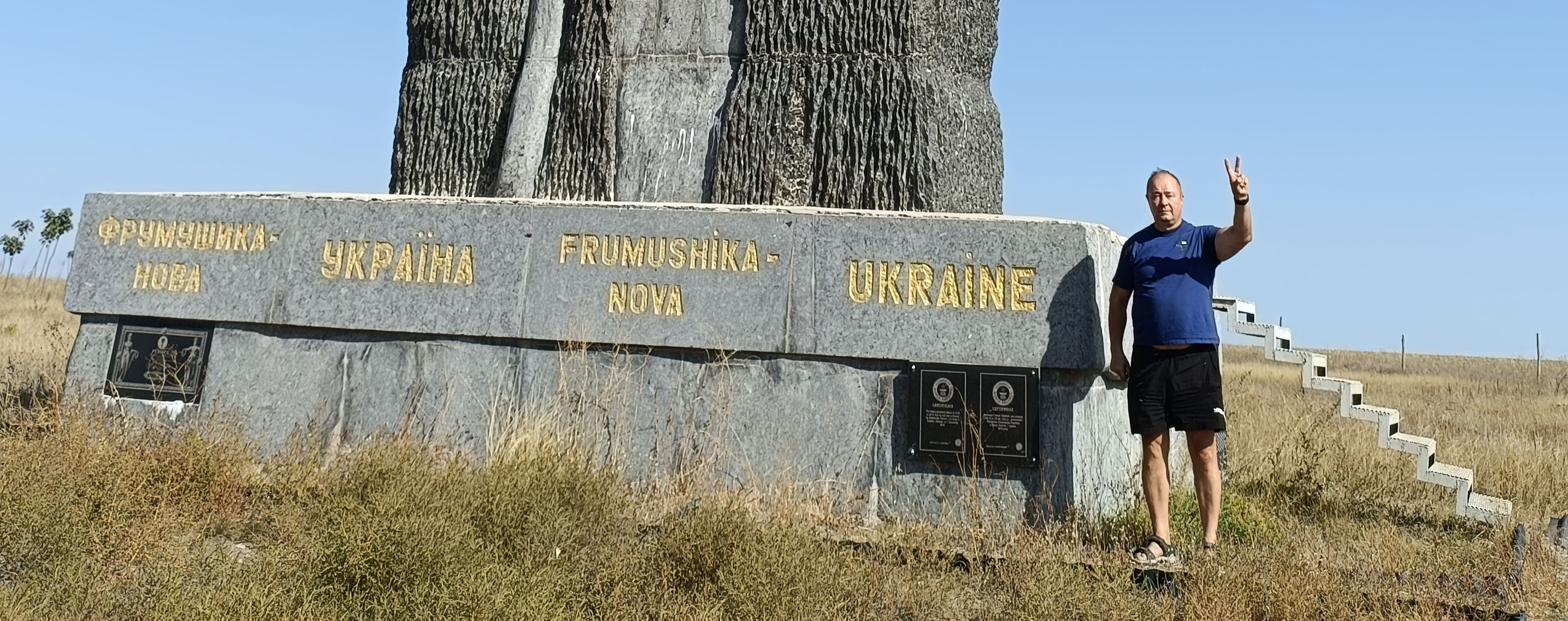










.png)






